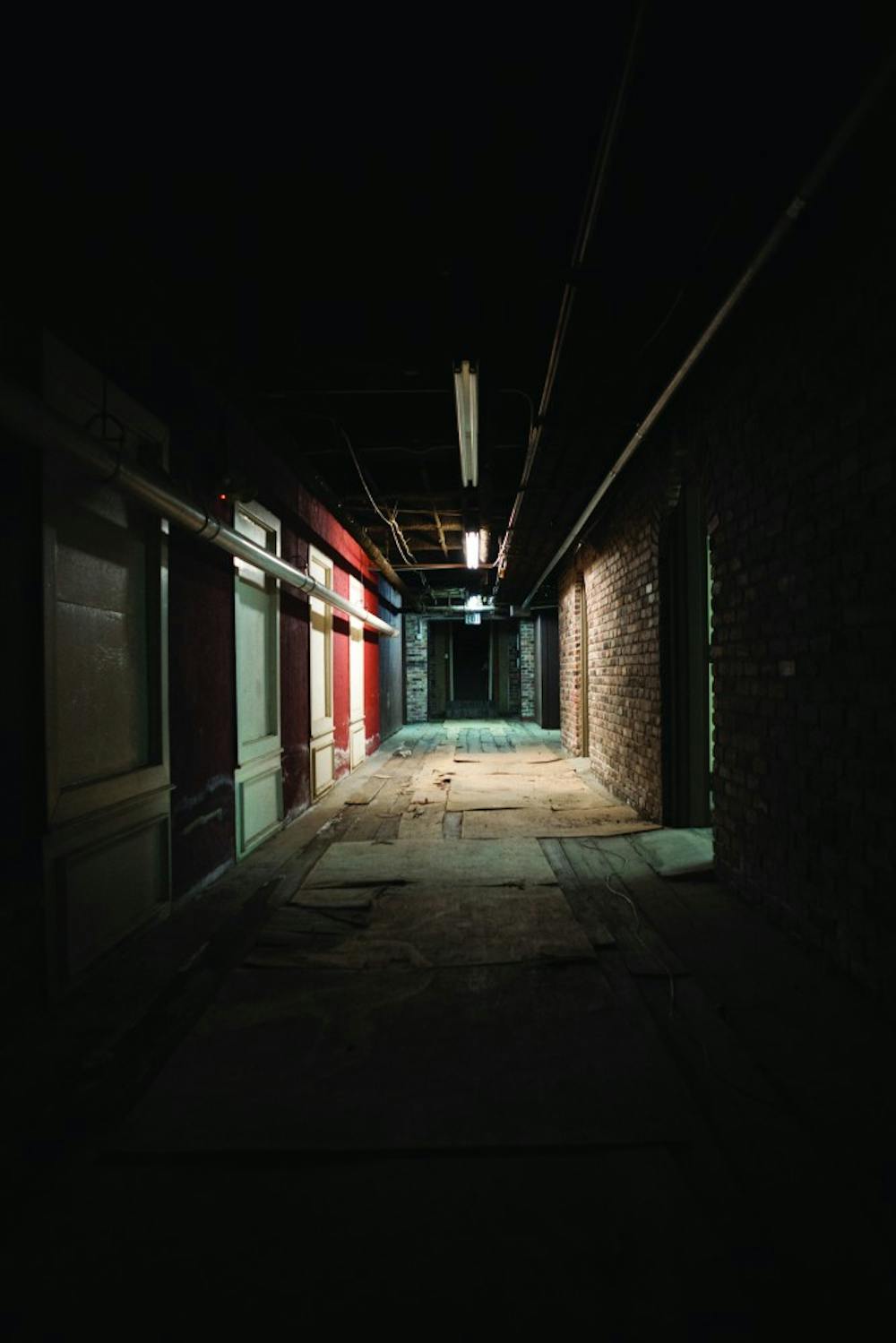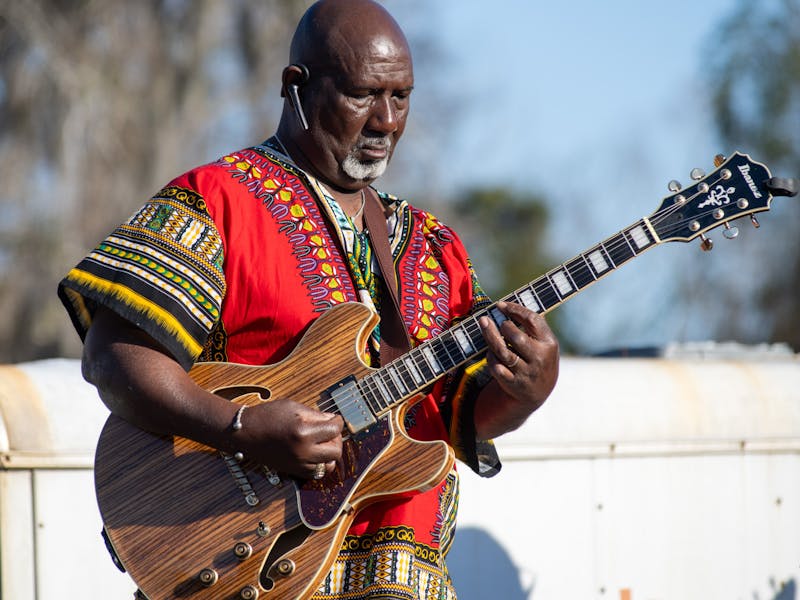A man in a feathered brown wig emerges from a hole in the ground and asks me if I remember the seventies. I don’t, of course, but hands shoot up all around me in the massive Historic Columbia tour group. We are gathered in the portico of the Equitable Arcade Mall on Main Street. Passersby give our guide strange looks and our group a wide berth. The property owner mills around the atrium. A woman in a fluorescent pink and yellow dress holding an electric lantern, disappears below the surface of the earth. Below us, a catacomb-like space still hums with the spirit of 1971.
But I’m about 104 years ahead of myself. The Arcade on Main Street was completed in 1912 to the tune of $200,000. Its design was state-of-the art. There was nothing else like it in the state of South Carolina. Shopping malls were a relatively new institution and took time to spread to the Southern United States. To the folks at the turn of the century, the Arcade was modern. It was dynamic. It was glass and steel and masonry, carefully combined to create a one-of-a-kind shopping experience in the state capitol. People flocked to this space. Families traveled overnight to catch a glimpse of the arcade while it was still under construction. It becomes an iconic Main Street landmark before it even opens its doors in 1912.
Something else that happens in 1912? An ocean liner grazes an iceberg on its way to New York. Columbia’s flagship arcade mall is christened as the Titanic sinks. The irony is not lost on the folks at Historic Columbia. But the joke won’t stick for another sixty years when the Arcade enters its second life as a nightclub district.
Columbia Underground opened in 1971 and hosted a variety of clubs, restaurants, bars, and shops on the basement level of the Arcade Building. Modeled after famed Underground Atlanta, Columbia Underground aimed to create an attractive nightlife atmosphere in the heart of Downtown. For three years, that’s exactly what it did. Young people, families, college students, and out-of-towners enjoyed a unique experience, tucked away beneath street level.
After three years, however, things became strained and Columbia Underground was forced to close its doors.
Today, the Equitable Arcade has been acquired by Peach Properties, a Columbia-based developer responsible for rehabilitating it to its former glory. And that’s part of the reason I’m standing in the lobby of the Arcade, along with nearly one hundred other members of Historic Columbia. We listen politely as the co-owner of Peach Properties, a well-dressed young man with a trendy haircut, explains the renovations his company will carry out on the atrium. He goes into great detail about the care Peach Properties has taken to ensure the building’s current tenants (a barber, a handful of galleries, One Columbia for Arts and Culture, and various corporate offices) are satisfied.
This is exciting, we all agree. But what we really want to see is beneath our feet. A catacomb of deserted bars is rumored to exist in otherworldly-stillness beneath the Arcade. Every once in a while, Historic Columbia, a private non-profit preservation society, prizes up the cellar door and invites its members to descend into a realm most Columbia residents have never seen before.
I’m here because I’m nosy. Rumors of the USC catacombs run rampant and I’m jonesing to see what an underground world, locked up and abandoned, looks like. So I find myself drinking complimentary River Rat and milling around with Columbia’s friendliest group of history buffs. They’ve gathered around the shag carpet-catacomb entrance half an hour before the first tour is even set to leave. When our be-wigged tour guide rises like a ghost from below, the crowd goes silent immediately, totally captivated.
“What do y’all remember about the ‘70s?” he asks. “Anything?” The crowd laughs. People start sharing stories so wild they make me blush into my beer. The woman next to me asks what I’m doing with a notebook out. I explain that I’m a reporter.
“Well, he,” she said with a low voice, nodding to Sherrer. “Looks just like someone I used to know.” I laugh. She doesn’t. “I’m serious,” she says. “Except the guy I knew wouldn’t be caught dead without wingtip shoes.”
John Sherrer, the man in the wig with disappointingly rounded-toe shoes, also happens to be the Director of Cultural Resources at Historic Columbia. As if the outfit didn’t reveal his enthusiasm for the site, the tour he leads certainly does.
I follow a man in a white suit (“Like I wore when this place was still serving drinks!”) into the narrow entrance to the space. The stairs are a steep slope and I have to duck not to hit my head. The passage is dark and cool. It smells, strangely enough, like Thomas Cooper library. (This probably has something to do with the old newspapers plastered around to black out windows.) It takes a moment for my eyes to adjust. Though the space is dotted with flood lights, the dark-paneled walls and long hallway inexorably dim the space. Cobwebs hang so thickly from the rafters, it looks like someone’s mother got over-enthusiastic with Halloween decorations.
When I say there’s an underground world beneath the Arcade, I’m not exaggerating. There are shops and bars and nightclubs all abandoned. Bathrooms are covered in graffiti from 1971, a time when Earth, Wind, & Fire were turning out number ones. Nixon’s approval rate was still high. Smoking happened almost exclusively indoors. Elvis was still alive. Star Wars hadn’t been released yet.
John directs us into bar-after-bar. They all have their own themes—or remnants of them at least—Jim’s Place is all red velvet. The carpet is long gone, giving the whole room a haunted look. We’re using cell phones as flashlights to peer into dark corners. Across the hall is a trolley-turned-bar. Its paint has peeled, but still stands fully-intact. Real curtains hang across false windows in the corridor. Some doors hang off their hinges, some are gone completely, and some are sealed shut. I am struck by how eerily similar this all looks to photographs of shipwrecks I’ve seen. Every time I turn around, I expect a James Cameron-like transition to Columbia Underground’s glory days.
And though Leonardo DiCaprio doesn’t emerge, other characters do. Claire de Lune, an alumni DJ at WUSC is on the tour. During our stop at the SoHo Place Limited, a British-themed restaurant, she remembers very clearly her time working as a waitress. By day, SoHo operated as a restaurant. After hours, it was as Mod as you could get in Columbia. Probably even South Carolina. It was a veritable go-go, she says. Claire tells us about her uniform: a short, tight skirt, tall boots, and a wallet filled with tip money.
In this space, totally captivated, I can’t help but wonder why no one has remodeled and reopened the space to the public. “I know it would take a lot of effort, it would take a lot of money, a lot of capital expenses,” Sherrer tells me later. “You would have to do things to physically alter the building. There’s some really cool stuff there, but a lot of the stuff is pretty deteriorated. Not all of it. There’s some facets of those bars that could be saved and reincorporated. I think just the general idea of reopening 14000 square feet underneath a building, captured people’s imagination in 1971, it would continue to do that today.”
Rumors of contractors’ bids ebb and flow like tidewater. Something will become of the space, I have no doubt, it may just be another 30 years before it’s open to the public again.
As the tour comes to an end, I wonder what the virtue is in all this. Is there reprieve in renovations and tours and tickets? According to Sherrer, the Arcade Mall is an integral part of the fabric of Downtown Columbia. “Generations of people have interacted with the building. It’s something that’s a character-defining feature of Columbia and so retaining those architectural elements that make it important, that make it what it is, is something that is important to do. It’s an investment. But it’s an investment for cultural as well as financial dividends.”
The life of Underground Columbia was not a long one. It fought to make a profit for three years before finally boarding up its fake windows and ripping up the shag. The financial strategy it would take to unsink such a ship are immense. But with an increased student population living a block away at the Hub, the future may not be that far away.
Let me leave you with this: Around the turning point of Cola Underground’s life, a fistfight broke out in one of the bars. A band called Iron and Lace were performing that night (on a stage shaped like a functioning draw-bridge no less!) and over the din of the brawl, the bartender—making no tips and a scant profit—commanded them to keep playing. Fists flew, glass shattered, the ship was sinking, and the band played on.



